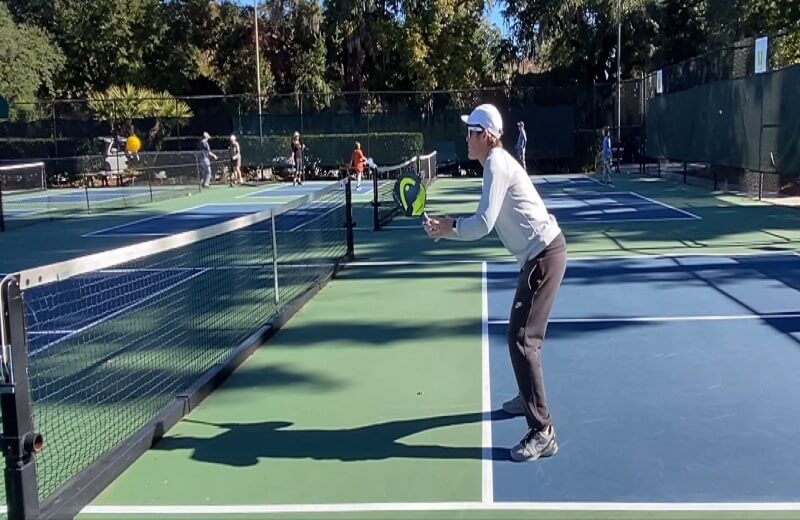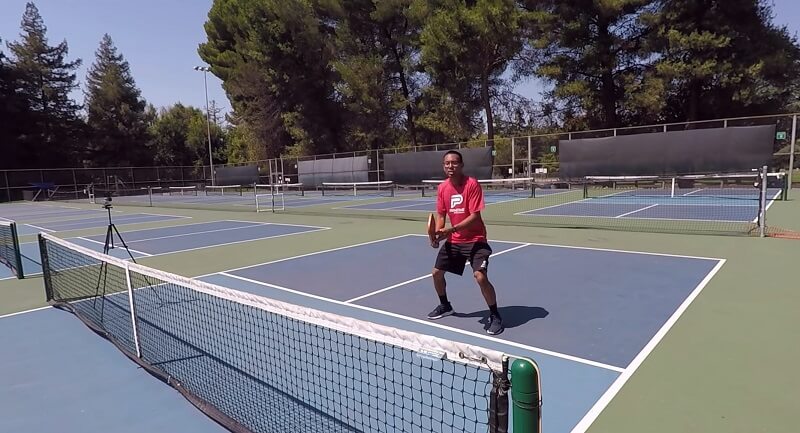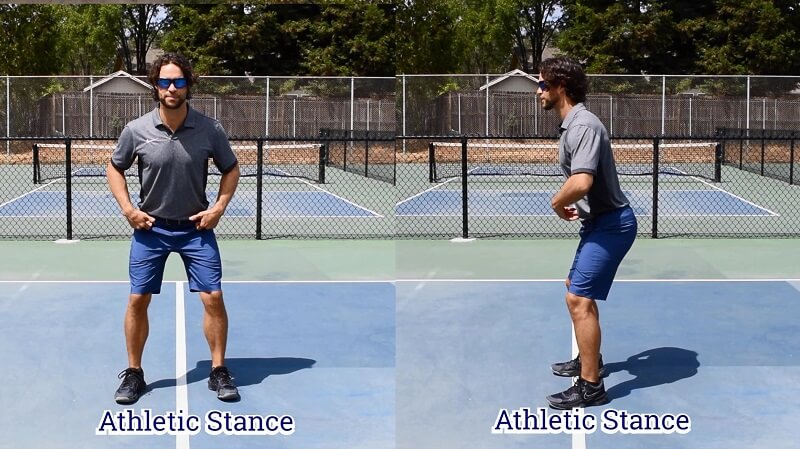The Pickleball Ready Time Position
Usually, the most common mistake made by players when you move to the kitchen line or in the kitchen line is the paddle dangling at your side. Besides that, with the paddle down, then you will not be able to place the paddle in the right position quickly to make a shot. You can also hold your paddle in the paddle position above and in front of your body. Here are 2 different ways to paddle position and body position.
Your Paddle Position In Pickleball Ready Time
In preparation for the rowing position, there will be some preparations in this position that you need to prepare.
-
Paddle Angle Selection
On the pickleball court, pickleball shots can arrive on any path. It contains your body’s forehand as well as backhand parts. Unless you want a paddle angle that allows you to strike and protect shots from your forehand and backhand parties. Having said that, the angle of your pickleball paddle may change depending on whether intensely you are on the pickleball court.
- Located Near Baseline
When you are next to the pickleball court’s baseline. For example, if you’re returning a serve, your paddle placement should be more objective. However, if you assume yourself standing on a clock face, your pickleball paddle is at 12 o’clock. A significant proportion of pickleball shots from the baseline will be forehand, as forehand shots are usually better than backhand shots. As a consequence, the paddle placement at 12 o’clock will allow you enough time to prepare your forehand shot from the baseline, as well as hedging purposes in case you hit a backhand by this court place.
- Being In The Transition Zone And Non-Volley Zone
As you progress up to the Kitchen line, your paddle angle becomes more significant as you get less and less time to respond to your opposition’s strokes. To protect both sides of your body as you ascend the pickleball court, your paddle face should be at 10 or 11 o’clock if you assume yourself leaning on a digital display or 2 or 1 o’clock since you’re a left winger. As you ought to be in a semi-backhand place, your opponent must be able to see the face of your paddle. This semi-backhand position enables you to respond faster to strokes even while allowing you to switch your paddle and strike a forehand. However, when you are a left winger, begin not to over-rotate to the 9 o’clock or 3 o’clock placements. Because you’ll be too focused on backhands. Keep your paddle face within the 10 or 11 o’clock or 2 or 1 o’clock placement when you are a left winger.
- Read more: “Pickleball Grip: 3 Ways To Hold Your Paddle”
-
Pay Attention to the Paddle Height
The height at which you retain your paddle is also an aspect of your pickleball paddle position. Pickleball players have traditionally believed their paddles are all over shoulder height. Moreover, there is a growing trend of lowering the paddle to the belly button. This is a result that if you retain your paddle at shoulder height, everything above your paddle head will probably be considered out of bounds. As a consequence, it is not necessary to progress your paddle upwards toward this proper position because you will not be hitting your opposition’ out-of-bounds strokes.
However, to cover any strokes from your opposition, you must shift your paddle downward, which takes longer. Usually, the paddle is moved downwards, but not upwards, this starts when you are in a position that is not ready to paddle and takes longer, to attack or keep the stroke below your chest height. Sure, by wrapping your pickleball paddle all over your belly, you will have the same amount of space to move to go high for a shot and down for a low cross. As a consequence, you can protect the most shots or keep on the pickleball court within the shortest amount of time.
- Read more: “How to Keep the Ball Low in Pickleball and Control the Game”
-
Point the paddle forward and the paddle head up a little
Your arms must be slightly bent or not fully extended, and your pickleball paddle must be positioned in front of your chest, visible in your field of vision. Unless your arms are excessively outstretched, you will lose power or spend so much time helping to bring your arm up to stack for your shots. In contrast, side, if your arms and pickleball paddle became too near to your body, you do have not enough room to respond to your opposition’s shot, and your shots will jam in several situations. Stay your paddle head barely up, rather than down at the ground.
Your Body Position In Pickleball Ready Time
Next is your body position for pickleball-ready time. Here is the explanation:
-
Open Feet Shoulder Width
Set your feet shoulder-wide apart. You like to feel secure and balanced, just like you are sitting on a solid foundation. Even so, if your feet are as wide, you will be slow to move from side to side. This should be easier if your feet are about shoulder length apart or a bit larger than shoulder-width apart.
-
Posture Like Athletics
Put your knees bent and your muscle mass on the balls and insides of your feet to get into an athletic place. Consider this role to be similar to every other game. For instance, a baseball or softball player who is prepared to field a ball. It is critical to keep your bent knees and your muscle mass on the balls of your feet to shift and respond quickly to the pickleball.
Conclusion
Those are some ways to position in pickleball ready time that you can use. If you are already in the pickleball ready time position, you can move quickly whichever is the same as the correct rowing position. In addition, the correct position of the paddle is when the position of the paddle is above and in front of the body when the opponent is about to hit the ball.
Related Articles:
- The Ultimate Guide: How to Get Better at Pickleball
- The 15 Pickleball Tips for Intermediate Players You Need to Know
- 8 Simple Pickleball Tricks For Beginners To Quickly Improve In-Game
- How To Serve In Pickleball: Tips to Improve Your Game
- Where To Stand In Pickleball: Positioning Guide For Beginners
- How To Hit a Pickleball Harder: Using Spin to Increase Your Shot Power




